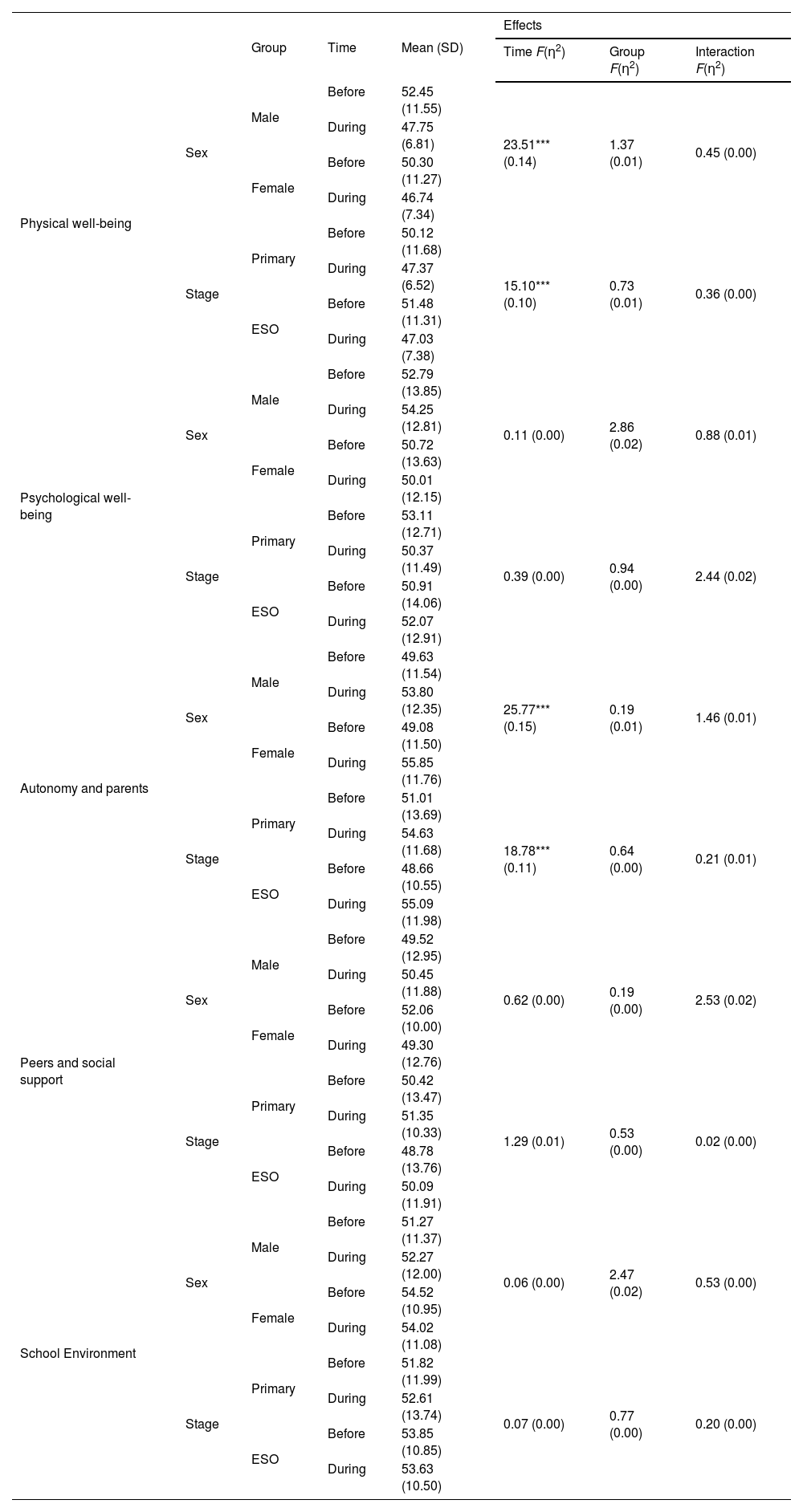The state of alarm declared in Spain due to the coronavirus disease 2019 (COVID-19) pandemic lasted for 98 days, during which the Spanish population was under strict home confinement.
Health-related quality of life (HRQoL) is a widely studied construct in the literature that refers to a state of physical, mental, and social well-being.1 The objective of our study was to compare HRQoL in preadolescents in Spain before and during the COVID-19 lockdown.
We conducted a 2-wave longitudinal study (wave 1, December 2019; wave 2, lockdown period, at least 62 days after it began). The participants were 165 students (38.2% male) from year 6 of primary education to year 2 of compulsory secondary education (ESO in Spanish) enrolled in 5 schools in the regions of Aragón, Asturias and Castilla y León in Spain.
We used the KIDSCREEN-27.2 This version assesses 5 dimensions with 27 items. The reliability indicators were adequate.
We obtained consent for participation of the students, and the study was approved by the schools and the research ethics committee.
We found significant differences in physical well-being, with a substantial decrease during the lockdown (P < .001) during the lockdown. In contrast, scores for the autonomy and parents dimension increased during the lockdown (P < .001) (Table 1). We did not found significant differences based on sex or educational stage.
Repeated-measures ANOVA (before and during the lockdown) of HRQoL by sex and educational stage.
| Group | Time | Mean (SD) | Effects | ||||
|---|---|---|---|---|---|---|---|
| Time F(η2) | Group F(η2) | Interaction F(η2) | |||||
| Physical well-being | Sex | Male | Before | 52.45 (11.55) | 23.51*** (0.14) | 1.37 (0.01) | 0.45 (0.00) |
| During | 47.75 (6.81) | ||||||
| Female | Before | 50.30 (11.27) | |||||
| During | 46.74 (7.34) | ||||||
| Stage | Primary | Before | 50.12 (11.68) | 15.10*** (0.10) | 0.73 (0.01) | 0.36 (0.00) | |
| During | 47.37 (6.52) | ||||||
| ESO | Before | 51.48 (11.31) | |||||
| During | 47.03 (7.38) | ||||||
| Psychological well-being | Sex | Male | Before | 52.79 (13.85) | 0.11 (0.00) | 2.86 (0.02) | 0.88 (0.01) |
| During | 54.25 (12.81) | ||||||
| Female | Before | 50.72 (13.63) | |||||
| During | 50.01 (12.15) | ||||||
| Stage | Primary | Before | 53.11 (12.71) | 0.39 (0.00) | 0.94 (0.00) | 2.44 (0.02) | |
| During | 50.37 (11.49) | ||||||
| ESO | Before | 50.91 (14.06) | |||||
| During | 52.07 (12.91) | ||||||
| Autonomy and parents | Sex | Male | Before | 49.63 (11.54) | 25.77*** (0.15) | 0.19 (0.01) | 1.46 (0.01) |
| During | 53.80 (12.35) | ||||||
| Female | Before | 49.08 (11.50) | |||||
| During | 55.85 (11.76) | ||||||
| Stage | Primary | Before | 51.01 (13.69) | 18.78*** (0.11) | 0.64 (0.00) | 0.21 (0.01) | |
| During | 54.63 (11.68) | ||||||
| ESO | Before | 48.66 (10.55) | |||||
| During | 55.09 (11.98) | ||||||
| Peers and social support | Sex | Male | Before | 49.52 (12.95) | 0.62 (0.00) | 0.19 (0.00) | 2.53 (0.02) |
| During | 50.45 (11.88) | ||||||
| Female | Before | 52.06 (10.00) | |||||
| During | 49.30 (12.76) | ||||||
| Stage | Primary | Before | 50.42 (13.47) | 1.29 (0.01) | 0.53 (0.00) | 0.02 (0.00) | |
| During | 51.35 (10.33) | ||||||
| ESO | Before | 48.78 (13.76) | |||||
| During | 50.09 (11.91) | ||||||
| School Environment | Sex | Male | Before | 51.27 (11.37) | 0.06 (0.00) | 2.47 (0.02) | 0.53 (0.00) |
| During | 52.27 (12.00) | ||||||
| Female | Before | 54.52 (10.95) | |||||
| During | 54.02 (11.08) | ||||||
| Stage | Primary | Before | 51.82 (11.99) | 0.07 (0.00) | 0.77 (0.00) | 0.20 (0.00) | |
| During | 52.61 (13.74) | ||||||
| ESO | Before | 53.85 (10.85) | |||||
| During | 53.63 (10.50) | ||||||
ESO, Spanish compulsory secondary education; SD, standard deviation.
The significant decrease in physical well-being could be expected given the restrictions to free movement and suspension of face-to-face classes and activities. This situation affecting a large portion of European children and adolescents was a major source of concern3 and should be taken into account in case of future total or partial lockdown situations.
When it comes to the significant increase in the autonomy and parents score, there are several possible explanations: 1) an adaptation to the pandemic through coping strategies4 that buffered the potential negative impact on HRQoL; 2) the time available to legal guardians and devoted to the children, which may have increased due to the confinement. According to the attachment and the self-expansion theories, when parents and children spend more time together, their mutual understanding and psychological well-being increase.
There are limitations to our study, including collection of data with a self-reporting instrument and the size of the sample, and therefore it should be considered merely exploratory. Nevertheless, the results show that in the case of future confinement, it would be important to provide access to outdoor recreational areas with implementation of COVID-19 prevention protocols (use of mask, implementation of staggered schedules and use of vaccination certificates, as applicable) to ensure physical well-being.
FundingThis study was funded by the Spanish Ministry of Economy, Industry and Competitiveness (project RTI2018-094212-B-I00, CIBER-AACC) and the International University of La Rioja (Cyberpsychology project, 2017-2020 and 2020-2022 trienniums).
Ethical considerationsThe study was approved by the Research Ethics Committee of the International University of la Rioja (research project 004/2019).
Please cite this article as: González-Cabrera J, Ortega-Barón J, Montiel I, Machimbarrena JM. Calidad de vida relacionada con la salud en preadolescentes antes y durante el confinamiento. An Pediatr (Barc). 2022;97:215–217.




